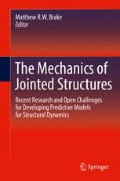Abstract
This chapter describes the development of a reduced-order, modal framework for the simulation of structural dynamics incorporating the effect of isolated joints. The effect of the joint is included within the modal structure of the system, which can be identified from the dynamic response at low excitation levels when the system behaves linearly. Then, the joint is represented by a reduced-order model for the distributed interface developed from an appropriate shell theory. This reduced-order joint model can be viewed as the continuum limit of a series–series Iwan model. Finally, the overall approach is illustrated on a simple discrete structural system. The resulting simulation is computationally efficient and is described in terms of joint parameters that can easily be related back to measurable quantities such as the coefficient of friction.
Access this chapter
Tax calculation will be finalised at checkout
Purchases are for personal use only
References
S. Bograd et al., Modeling the dynamics of mechanical joints. Mech. Syst. Signal Process. 25, 2801–2826 (2011)
R. Courant, K. Friedrichs, H. Lewy, Über die Partiellen Differenzengleichungen der Mathematischen Physik (On the Partial Difference Equations of Mathematical Physics). Math. Ann. 100(1), 32–74 (1928)
B.J. Deaner et al., Application of viscous and Iwan modal damping models to experimental measurements from bolted structures. ASME J. Vib. Acoust. 137, 021012 (2015)
M. Eriten et al., Nonlinear system identification of frictional effects in a beam with a bolted joint connection. Mech. Syst. Signal Process. 39, 245–264 (2013)
W.D. Iwan, A distributed-element model for hysteresis and its steady state dynamic response. ASME J. Appl. Mech. 33, 893–900 (1966)
A. Libai, J.G. Simmonds, The Nonlinear Theory of Elastic Shells, 2nd edn. (Cambridge University Press, Cambridge, 1998)
J.D. Miller, D.D. Quinn, A two-sided interface model for dissipation in structural systems with frictional joints. J. Sound Vib. 321, 201–219 (2009)
D.D. Quinn, Modal analysis of jointed structures. J. Sound Vib. 331, 81–93 (2012)
D.D. Quinn, D.J. Segalman, Using series-series Iwan-type models for understanding joint dynamics. ASME J. Appl. Mech. 72, 778–784 (2005)
T.J. Royston, Leveraging the equivalence of hysteresis models from different fields for analysis and numerical simulation of jointed structures. ASME J. Comput. Nonlinear Dyn. 3, 031006 (2008)
D.J. Segalman, A four-parameter Iwan model for lap-type joints. ASME J. Appl. Mech. 72, 752–760 (2005)
D.J. Segalman, A modal approach to modeling spatially distributed vibration energy dissipation. Technical Report SAND2010-4763. Sandia National Laboratories, Albuquerque, NM (2010)
D.J. Segalman, M.J. Starr, Inversion of Masing models via continuous Iwan systems. Int. J. Nonlinear Mech. 43, 74–80 (2008)
Y. Song et al., Simulation of dynamics of beam structures with bolted joints using adjusted Iwan beam elements. J. Sound Vib. 273, 249–276 (2004)
Author information
Authors and Affiliations
Corresponding author
Editor information
Editors and Affiliations
Rights and permissions
Copyright information
© 2018 Springer International Publishing AG
About this chapter
Cite this chapter
Brink, A., Quinn, D.D., Segalman, D.J. (2018). Application of Continuum Shell Models for Joint Dissipation. In: Brake, M. (eds) The Mechanics of Jointed Structures. Springer, Cham. https://doi.org/10.1007/978-3-319-56818-8_28
Download citation
DOI: https://doi.org/10.1007/978-3-319-56818-8_28
Published:
Publisher Name: Springer, Cham
Print ISBN: 978-3-319-56816-4
Online ISBN: 978-3-319-56818-8
eBook Packages: EngineeringEngineering (R0)

